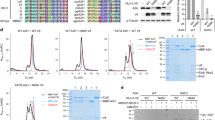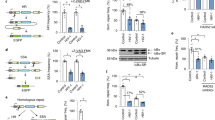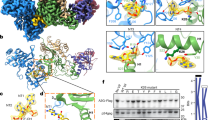Abstract
The viral infectivity factor (Vif) encoded by HIV-1 neutralizes a potent antiviral pathway that occurs in human T lymphocytes and several leukemic T-cell lines termed nonpermissive, but not in other cells termed permissive. In the absence of Vif, this antiviral pathway efficiently inactivates HIV-1. It was recently reported that APOBEC3G (also known as CEM-15), a cytidine deaminase nucleic acid–editing enzyme, confers this antiviral phenotype on permissive cells. Here we describe evidence that Vif binds APOBEC3G and induces its rapid degradation, thus eliminating it from cells and preventing its incorporation into HIV-1 virions. Studies of Vif mutants imply that it contains two domains, one that binds APOBEC3G and another with a conserved SLQ(Y/F)LA motif that mediates APOBEC3G degradation by a proteasome-dependent pathway. These results provide promising approaches for drug discovery.
This is a preview of subscription content, access via your institution
Access options
Subscribe to this journal
Receive 12 print issues and online access
$209.00 per year
only $17.42 per issue
Buy this article
- Purchase on Springer Link
- Instant access to full article PDF
Prices may be subject to local taxes which are calculated during checkout






Similar content being viewed by others
References
Gabuzda, D.H. et al. Role of vif in replication of human immunodeficiency virus type 1 in CD4+ T lymphocytes. J. Virol. 66, 6489–6495 (1992).
Madani, N. & Kabat, D. An endogenous inhibitor of human immunodeficiency virus in human lymphocytes is overcome by the viral Vif protein. J. Virol. 72, 10251–10255 (1998).
Simon, J.H., Gaddis, N.C., Fouchier, R.A. & Malim, M.H. Evidence for a newly discovered cellular anti-HIV-1 phenotype. Nat. Med. 4, 1397–1400 (1998).
Sheehy, A.M., Gaddis, N.C., Choi, J.D. & Malim, M.H. Isolation of a human gene that inhibits HIV-1 infection and is suppressed by the viral Vif protein. Nature 418, 646–650 (2002).
Gaddis, N.C., Chertova, E., Sheehy, A.M., Henderson, L.E. & Malim, M.H. Comprehensive investigation of the molecular defect in vif-deficient human immunodeficiency virus type 1 virions. J. Virol. 77, 5810–5820 (2003).
Ochsenbauer, C., Wilk, T. & Bosch, V. Analysis of vif-defective human immunodeficiency virus type 1 (HIV-1) virions synthesized in 'non-permissive' T lymphoid cells stably infected with selectable HIV-1. J. Gen. Virol. 78, 627–635 (1997).
von Schwedler, U., Song, J., Aiken, C. & Trono, D. Vif is crucial for human immunodeficiency virus type 1 proviral DNA synthesis in infected cells. J. Virol. 67, 4945–4955 (1993).
Courcoul, M. et al. Peripheral blood mononuclear cells produce normal amounts of defective Vif- human immunodeficiency virus type 1 particles which are restricted for the preretrotranscription steps. J. Virol. 69, 2068–2074 (1995).
Simon, J.H. & Malim, M.H. The human immunodeficiency virus type 1 Vif protein modulates the postpenetration stability of viral nucleoprotein complexes. J. Virol. 70, 5297–5305 (1996).
Dettenhofer, M., Cen, S., Carlson, B.A., Kleiman, L. & Yu, X.F. Association of human immunodeficiency virus type 1 Vif with RNA and its role in reverse transcription. J. Virol. 74, 8938–8945 (2000).
Goncalves, J., Korin, Y., Zack, J. & Gabuzda, D. Role of Vif in human immunodeficiency virus type 1 reverse transcription. J. Virol. 70, 8701–8709 (1996).
Teng, B., Burant, C.F. & Davidson, N.O. Molecular cloning of an apolipoprotein B messenger RNA editing protein. Science 260, 1816–1819 (1993).
Harris, R.S., Petersen-Mahrt, S.K. & Neuberger, M.S. RNA editing enzyme APOBEC1 and some of its homologs can act as DNA mutators. Mol. Cell 10, 1247–1253 (2002).
Liu, H. et al. The Vif protein of human and simian immunodeficiency viruses is packaged into virions and associates with viral core structures. J. Virol. 69, 7630–7638 (1995).
Khan, M.A. et al. Human immunodeficiency virus type 1 Vif protein is packaged into the nucleoprotein complex through an interaction with viral genomic RNA. J. Virol. 75, 7252–7265 (2001).
Lecossier, D., Bouchonnet, F., Clavel, F. & Hance, A.J. Hypermutation of HIV-1 DNA in the absence of the Vif protein. Science 300, 1112 (2003).
Zhang, H. et al. The cytidine deaminase CEM15 induces hypermutation in newly synthesized HIV-1 DNA. Nature 424, 94–98 (2003).
Mangeat, B., Turelli, P., Caron, G., Friedli, L.P. & Trono, D. Broad antiretroviral defense by human Apobec3G through lethal editing of nascent reverse transcripts. Nature 424, 99–103 (2003).
Harris, R.S. et al. DNA deamination mediates innate immunity to retroviral infection. Cell 113, 803–809 (2003).
Mariani, R. et al. Species-specific exclusion of APOBEC3G from HIV-1 virions by Vif. Cell 114, 21–31 (2003).
Oberste, M.S. & Gonad, M.A. Conservation of amino-acid sequence motifs in lentivirus Vif proteins. Virus Genes 6, 95–102 (1992).
Page, K.A., Landau, N.R. & Littman, D.R. Construction and use of a human immunodeficiency virus vector for analysis of virus infectivity. J. Virol. 64, 5270–5276 (1990).
Madani, N. & Kabat, D. Cellular and viral specificities of human immunodeficiency virus type 1 vif protein. J. Virol. 74, 5982–5987 (2000).
Simon, J.H., Sheehy, A.M., Carpenter, E.A., Fouchier, R.A. & Malim, M.H. Mutational analysis of the human immunodeficiency virus type 1 Vif protein. J. Virol. 73, 2675–2681 (1999).
Garrett, E.D., Tiley, L.S. & Cullen, B.R. Rev activates expression of the human immunodeficiency virus type 1 vif and vpr gene products. J. Virol. 65, 1653–1657 (1991).
Gluschankof, P., Mondor, I., Gelderblom, H.R. & Sattentau, Q.J. Cell membrane vesicles are a major contaminant of gradient-enriched human immunodeficiency virus type-1 preparations. Virology 230, 125–133 (1997).
Verma, R. & Deshaies, R.J. A proteasome howdunit: the case of the missing signal. Cell 101, 341–344 (2000).
Kamura, T. et al. The elongin BC complex interacts with the conserved SOCS-box motif present in members of the SOCS, ras, WD-40 repeat, and ankyrin repeat families. Genes Dev. 12, 3872–3881 (1998).
Iwai, K. et al. Identification of the von Hippel-Lindau tumor-suppressor protein as part of an active E3 ubiquitin ligase complex. Proc. Natl. Acad. Sci. USA 96, 12436–12441 (1999).
Schubert, U. et al. CD4 glycoprotein degradation induced by human immunodeficiency virus type 1 Vpu protein requires the function of proteasomes and the ubiquitin-conjugating pathway. J. Virol. 72, 2280–2288 (1998).
Margottin, F. et al. A novel human WD protein, h-beta TrCp, that interacts with HIV-1 Vpu connects CD4 to the ER degradation pathway through an F-box motif. Mol. Cell 1, 565–574 (1998).
Desrosiers, R.C. et al. Identification of highly attenuated mutants of simian immunodeficiency virus. J. Virol. 72, 1431–1437 (1998).
Barnes, W.M. PCR amplification of up to 35-kb DNA with high fidelity and high yield from lambda bacteriophage templates. Proc. Natl. Acad. Sci. USA 91, 2216–2220 (1994).
Sambrook, J., Fritsch, E.F. & Maniatis, T. In vitro amplification of DNA by the polymerase chain reaction. in Molecular Cloning: A Laboratory Manual 14.5–14.34 (Cold Spring Harbor Laboratory Press, New York, 1989).
Helseth, E. et al. Rapid complementation assays measuring replicative potential of human immunodeficiency virus type 1 envelope glycoprotein mutants. J. Virol. 64, 2416–2420 (1990).
Page, K.A., Stearns, S.M. & Littman, D.R. Analysis of mutations in the V3 domain of gp160 that affect fusion and infectivity. J. Virol. 66, 524–533 (1992).
Platt, E.J., Kuhmann, S.E., Rose, P.P. & Kabat, D. Adaptive mutations in the V3 loop of gp120 enhance fusogenicity of human immunodeficiency virus type 1 and enable use of a CCR5 coreceptor that lacks the amino-terminal sulfated region. J. Virol. 75, 12266–12278 (2001).
Marin, M., Tailor, C.S., Nouri, A. & Kabat, D. Sodium-dependent neutral amino acid transporter type 1 is an auxiliary receptor for baboon endogenous retrovirus. J. Virol. 74, 8085–8093 (2000).
Klippel, A., Escobedo, J.A., Hirano, M. & Williams, L.T. The interaction of small domains between the subunits of phosphatidylinositol 3-kinase determines enzyme activity. Mol. Cell. Biol. 14, 2675–2685 (1994).
Tailor, C.S., Nouri, A., Lee, C.G., Kozak, C. & Kabat, D. Cloning and characterization of a cell surface receptor for xenotropic and polytropic murine leukemia viruses. Proc. Natl. Acad. Sci. USA 96, 927–932 (1999).
Acknowledgements
This research was supported by National Institutes of Health grant AI49729 to D.K. K.R. was the recipient of a predoctoral fellowship from the Department of Hematology and Oncology at Oregon Health & Science University. We thank D. Gabuzda for providing the pcDNA3.1-Vif vector, M. Malim for the Vif deletion mutants and M. Thayer for the S2 probe.
Author information
Authors and Affiliations
Corresponding author
Ethics declarations
Competing interests
The authors declare no competing financial interests.
Supplementary information
Rights and permissions
About this article
Cite this article
Marin, M., Rose, K., Kozak, S. et al. HIV-1 Vif protein binds the editing enzyme APOBEC3G and induces its degradation. Nat Med 9, 1398–1403 (2003). https://doi.org/10.1038/nm946
Received:
Accepted:
Published:
Issue Date:
DOI: https://doi.org/10.1038/nm946
This article is cited by
-
Structural basis of HIV-1 Vif-mediated E3 ligase targeting of host APOBEC3H
Nature Communications (2023)
-
Structural basis of antagonism of human APOBEC3F by HIV-1 Vif
Nature Structural & Molecular Biology (2019)
-
Polymorphisms in the APOBEC3G gene of Chinese rhesus macaques affect resistance to ubiquitination and degradation mediated by HIV-2 Vif
Archives of Virology (2019)
-
Autophagy during viral infection — a double-edged sword
Nature Reviews Microbiology (2018)
-
Moloney leukemia virus 10 (MOV10) inhibits the degradation of APOBEC3G through interference with the Vif-mediated ubiquitin–proteasome pathway
Retrovirology (2017)



